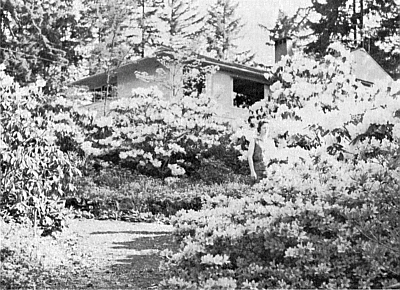QBARS - v28n1 Cecil and Molly Smith's Garden
Cecil and Molly Smith's Garden
Molly Grothaus, Lake Oswego, Oregon

|
|---|
FIG.4. R. 'Loder's White' towers above Molly Smith as she stands in the upper section of the Smith garden, which is included in one of the Annual Meeting tours in May. Photo by Cecil Smith |
Anyone who grows rhododendrons knows the minute he walks into this garden that the Cecil Smiths have found an ideal location. The sunlight filters down from high overhead shade gentle enough to keep rhododendron leaves at their greenest, but strong enough to make the plants set myriads of fat flower buds. The air feels cool and a bit moist, just the kind of atmosphere a rhododendron likes to wrap around itself. The ground underfoot is a springy forest duff that lures rhododendron roots to venture forth. Conditions like these have produced magnificent rhododendrons which make the two-acre garden look more mature than its 23 years. Situated about 30 miles southwest of Portland in the Willamette Valley, the garden faces north and slopes toward the river's flood plain. It is surrounded by a grove of native trees: overhead are white fir, Abies grandis , Douglas fir, Pseudotsuga menziesii , big leaf maple, Acer macrophyllum , with lower growing vine maple, Acer circinatum , and dogwood, Cornus nuttallii .
The Smiths have kept the area as natural looking as is possible without being overwhelmed by encroaching wilderness. Logs and stumps were left in place and as they rotted they have provided special planting sites for R. proteoides and other tiny gems. Vines such as Chinese gooseberry, Actinidia chinensis clamber up the tallest of the snags that were left. Most of the better rhododendron species, both lepidote and elepidote, which can be grown in this area are represented. Many of the large-leaved species are cut down by the cold every five or ten years, and the winter of 1972-3 was one of the years this happened.
A varied collection of British and American hybrids are mingled in pleasant combination with azaleas and a number of Cecil's own crosses. In addition to the original plant of 'Nestucca' there are crosses Cecil modestly rates as 'fair, indifferent and bad'. But the visitor to the garden will find them all interesting and be glad that Cecil has discovered, after a number of years of hybridizing, that the garden has a lot of plants not good enough to name but too good to throw away.
What the Smiths have is a collector's garden. While they attempted at first to arrange the plants in a rhythmic progression of foliage, size and color strength, their later objective was to make the plants happy. In this they have been embarrassingly successful. Although the rhododendrons were originally given what seemed to be generous amounts of space, overcrowding is becoming a problem and even some pruning is necessary to keep the trails open.
Supplemental watering for rhododendrons is necessary in this region every week or two from June until September during the months which have almost no rain and often have low daytime humidity. This makes it impractical to spread out rhododendrons through the woods as they are often grown in Scotland and sometimes on the East Coast. So instead of seeing scattered specimens throughout the Smiths' woods, the visitor to the garden in May will stand near their home and see the slope stretching out below in a splendor of bloom. An observing visitor will also see many choice little bulbs, interesting small native perennials and ground covers, as well as Japanese flowering cherries, magnolias, eucryphias, stewartias, camellias, and interesting secondary trees and vines.

